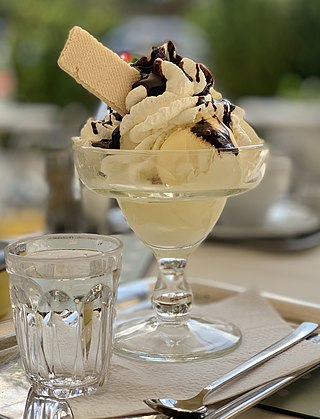
Ice cream is a frozen dessert typically made from milk or cream that has been flavoured with a sweetener, either sugar or an alternative, and a spice, such as cocoa or vanilla, or with fruit, such as strawberries or peaches. Food colouring is sometimes added in addition to stabilizers. The mixture is cooled below the freezing point of water and stirred to incorporate air spaces and prevent detectable ice crystals from forming. It can also be made by whisking a flavoured cream base and liquid nitrogen together. The result is a smooth, semi-solid foam that is solid at very low temperatures. It becomes more malleable as its temperature increases.
Winston Churchill (1874–1965) was a British statesman who led the United Kingdom and British Empire during the Second World War.
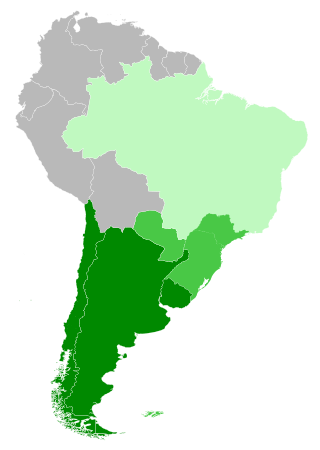
The Southern Cone is a geographical and cultural subregion composed of the southernmost areas of South America, mostly south of the Tropic of Capricorn. Traditionally, it covers Argentina, Chile, and Uruguay, bounded on the west by the Pacific Ocean and on the east by the Atlantic Ocean. In terms of social, economic and political geography, the Southern Cone comprises Argentina, Chile, and Uruguay, and sometimes includes Brazil's four southernmost states. In its broadest definition, taking into account common history and geography, it also includes Paraguay, another Spanish-speaking country.

Snow cream can be one of two distinct desserts.
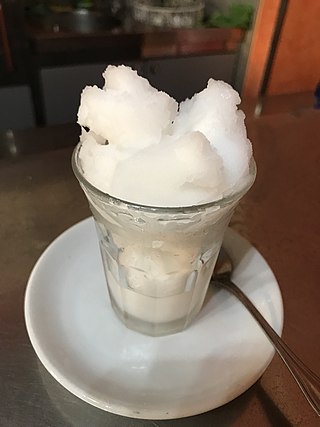
Granita is a semi-frozen dessert made from sugar, water and various flavorings. Originally from Sicily, it is available throughout Italy in varying forms. It is related to sorbet and Italian ice; however, in most of Sicily, it has a smoother, more crystalline texture. Food writer Jeffrey Steingarten says that "the desired texture seems to vary from city to city" on the island; on the west coast and in Palermo, it is at its chunkiest, and in the east, it is nearly as smooth as sorbet. This is largely the result of different freezing techniques: the smoother types are produced in a gelato machine, while the coarser varieties are frozen with only occasional agitation, then scraped or shaved to produce separated crystals. Although its texture varies from coarse to smooth, it is always different from that of ice cream, which is creamier, and from that of sorbet, which is more compact; this makes granita distinct and unique.

A snow cone is a variation of shaved ice or ground-up ice desserts commonly served in paper cones or foam cups. The dessert consists of ice shavings that are topped with flavored sugar syrup.

Puntarenas is a city in the Puntarenas canton of Puntarenas Province, on the Pacific coast of Costa Rica. As the seat of the Municipality of Puntarenas canton, it is awarded the title of city, which is made from the Puntarenas, Chacarita and El Roble districts. And as the city of the first canton of the province, it is the capital city of the Puntarenas Province as well, according to the Administrative divisions of Costa Rica.

Panela or rapadura is an unrefined whole cane sugar, typical of Central and Latin America. It is a solid form of sucrose derived from the boiling and evaporation of sugarcane juice. Panela is known by other names in Latin America, such as chancaca in Chile, Bolivia, and Peru, piloncillo in Mexico. Just like brown sugar, two varieties of piloncillo are available; one is lighter (blanco) and one darker (oscuro). Unrefined, it is commonly used in Mexico, where it has been around for at least 500 years. Made from crushed sugar cane, the juice is collected, boiled, and poured into molds, where it hardens into blocks. Elsewhere in the world, the word jaggery describes a similar foodstuff. Both are considered non-centrifugal cane sugars.

Gallo pinto or gallopinto is a traditional dish from Central America. Consisting of rice and beans as a base, gallo pinto has a long history and is important to Nicaraguan and Costa Rican identities and cultures, just as rice and beans variations are equally important in many Latin American cultures as well.
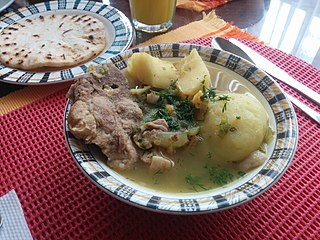
Sancocho is a traditional soup in several Latin American cuisines. Variations represent popular national dishes in Dominican Republic, Colombia, Cuba, Honduras, Ecuador, Panama, Puerto Rico, Trinidad and Tobago, and Venezuela. It usually consists of large pieces of meat, tubers and vegetables served in a broth.

Gofio is a sort of Canarian flour made from roasted grains or other starchy plants, some varieties containing a little added salt. Gofio has been an important ingredient in Canarian cooking for some time, and Canarian emigrants have spread its use to the Caribbean and the Western Sahara. There are various ways to use it, such as kneading, dissolving in soup, and baking. It can also be used as a thickener. It is also found in Argentina, Uruguay, and Chile, where it is known as harina tostada and is employed in a wide variety of recipes. The gofio commercially available in the Canary Islands is always finely ground, like ordinary flour, despite the definition given in the Spanish Dictionary of the Royal Academy. It can't be seen at shops other than the Canary Islands.

Bandeja paisa, with variations known as bandeja de arriero, bandeja montañera, or bandeja antioqueña, is one of the most representative meals in Colombian cuisine, especially of the Antioquia department and the Paisa Region, as well as with the Colombian Coffee-Growers Axis, and part of Valle del Cauca and the northwest of Tolima.
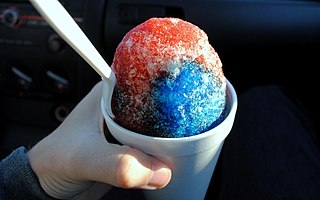
Shaved ice is a large family of ice-based desserts made of fine shavings of ice or finely crushed ice and sweet condiments or syrups. Usually, the syrup is added after the ice has been frozen and shaved—typically at the point of sale; however, flavoring can also be added before freezing. The dessert is consumed worldwide in various forms and ways. Shaved ice can also be mixed with large quantities of liquid to produce shaved ice drinks.

Shave ice or Hawaiian shave ice is an ice-based dessert made by shaving a block of ice and flavoring it with syrup and other sweet ingredients. On Hawai‘i Island, it is also referred to as "ice shave." In contrast, a snow cone, a similar American dessert, is made with crushed ice rather than shaved ice. The thin ice shavings of shave ice allow for the flavored syrups to be absorbed completely instead of sinking to the bottom. Hawaiian shave ice is derived from a similar ice-based dessert from Japan called kakigōri and thus involves similar production methods.
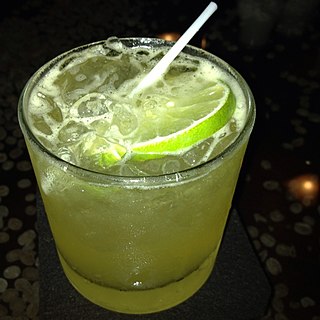
Guaro is a liquor made in many places in Latin America. A clear liquid distilled from sugar cane juices, it has a slightly sweeter taste than comparable liquors. It is traditionally 60 proof or 30% alcohol, although recently 70 proof and 80 proof versions are produced. It is popular in Colombia, Costa Rica, Ecuador, El Salvador, Guatemala, Honduras, Nicaragua, and Panama, although in many places the word "guaro" can refer to almost any liquor.
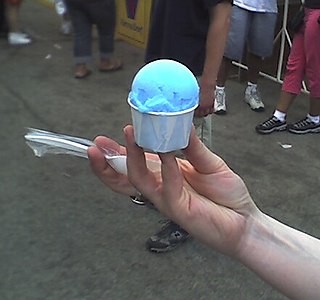
Blue raspberry is a manufactured flavoring and food coloring for candy, snack foods, syrups, and soft drinks. The flavor and color do not derive from any species of raspberry. According to Jerry Bowman, executive director of the Flavor & Extract Manufacturers Association of the United States as of 2016, the flavor profile of raspberry was developed using "mostly esters of the banana, cherry, and pineapple variety." Sugar is commonly used to create taste appeal for the blue raspberry flavoring.

The cuisine of Paraguay is the set of dishes and culinary techniques of Paraguay. It has a marked influence of the Guaraní people, in fusion with the Spanish cuisine and other marked influences coming from the immigration received by bordering countries such as Italian cuisine and Portuguese food. The gastronomy product of the syncretism and Hispanic-Guaraní fusion, is of greater weight in the Paraguayan history and considered the mother of the whole region, having Asunción as the starting point of many Spanish expeditions in the Southern Cone. It is worth clarifying that in society Paraguayan, the exchange of knowledge occurred between mestizos, criollos and guaraníes, before and even after the Jesuit missions. In 2017, the Ministry of the National Secretariat of Culture of Paraguay decided:
"Declare as 'Intangible Cultural Heritage of Paraguay' the production, handcrafted and traditional production of four typical Paraguayan meals still in force such as vori-vori, locro, Paraguayan soup and jopara and its recipes, knowledge, practices and knowledge that are passed down from generation to generation and document the material and immaterial elements associated with it as a cultural manifestation. "

Bastani, locally known as bastani sonnati or bastani sonnati zaferani, is an Iranian ice cream made from milk, eggs, sugar, rose water, saffron, vanilla, and pistachios. It is known widely as Persian ice cream. Bastani often contains flakes of frozen clotted cream. Sometimes, salep is included as an ingredient.

Costa Rica has a very strong beer industry centered on mass-produced Lagers. Imperial beer, produced by Florida Ice & Farm Co. is known and associated with Costa Rica all around the world.

The United States versus Costa Rica football (soccer) match was held on 22 March 2013 at the Dick's Sporting Goods Park in Commerce City, Colorado. It was part of the second matchday of the final qualification round in CONCACAF for the 2014 FIFA World Cup.


















